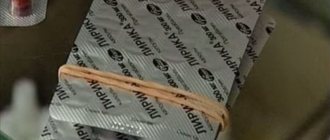Category: Benefits and harms
What is a tattoo? A tattoo is a permanent design on the body, made with a needle and the addition of a dye. Nowadays it is popular to decorate your body with long-lasting designs, but are there any negative consequences from this? What are the health risks of tattoos?
How is the design applied to the body? A coloring pigment is applied to the top layer of the skin with a needle or a special machine.
As a result, the skin becomes noticeably inflamed, bleeding and swollen. If the instruments are sterilized and the skin is properly treated, the inflammation goes away within a week or ten days.
Types of tattoos
- Classic - a drawing made by inserting a needle with a coloring pigment to a shallow depth. The paint is applied by a special machine, which, after piercing the skin, splashes out the paint. It is quite difficult to get rid of such a pattern, so recently young people have chosen the following option.
- Temporary tatoos. A special paint is applied to the skin, which fades over time and disappears completely. But there is one drawback: the process of lightening the pigment occurs gradually, so you will have to walk around with a faded pattern for some time. In addition, no one gives guarantees for complete disappearance. There have been cases where the trail remained for many years.
You can also hear about temporary tattoos without injecting ink under the skin. We are talking about mehendi. These pictures are not considered tattoos; they are practically harmless and wash off within a few days.
The benefits of tattoos, maybe temporary tattoos?
Are there any benefits to tattoos and does it cover the harm? The only benefit of a tattoo is beauty; if the design is temporary, it will bring more positive emotions. Thus, if you add up all the pros and cons, there will be more side effects from the tattoo procedure than benefits.
Temporary tattoos have not been proven to be harmful. They are applied only to the epidermis, and therefore do not penetrate the bloodstream and do not affect the health of the body. The most permanent temporary tattoo is mehendi.
You will like the article: “ Is vaping harmful to health or not?✅ “.
This is a henna design that will last on the body for about a month. Temporary tattoos are absolutely safe; they can be painted on pregnant women and small children. There are tattoos that last for several days. What are safe tattoos?
Types of temporary tattoos:
- Airbrush – using a stencil and an airbrush, paint is sprayed onto the body.
- Glitter – the design is applied using hypoallergenic glue and glitter.
- Crystal - gluing rhinestones to the skin.
- Transfers are stickers on the body. Now the trend is gold and silver tones, imitating bracelets, rings and necklaces.
The tattoo can be drawn with a gel pen. A suitable option is drawing at home. All you need is a stencil or sketch of the design, as well as hairspray to secure it.
Why tattoos are dangerous: expert opinion
According to research conducted by scientists, it was found that the paint used for tattoos contains many harmful substances. For example, in red there is mercury sulfide, in other shades there is titanium, chromium, lead and cadmium. But the most dangerous is considered to be blue, which contains cobalt and aluminum.
The negative consequences of tattoos can be caused by equipment. With its help, you can introduce an infection and provoke the emergence and development of diseases such as HIV, hepatitis B and C, and skin cancer. It is also prohibited to print pictures near moles.
The list of sad consequences continues with damage to muscle tissue. Therefore, doctors strongly recommend that you be especially careful when choosing a tattoo parlor.
What if you really want a tattoo?
Tattooing is not a temporary hobby. Sketching a drawing is a process no less painful than applying it. You should not agree with your desire if it is dictated by fashion or emotional impulse.
Determining how sincerely you want a tattoo is not difficult. Analyze your interest in your dream subject. How much do you know about tattoo styles and meanings? Are you ready to endure pain for hours and take long and painstaking care of the wound surface? How interested are you in the intricacies of the procedure?
Let's look at the most important dangers
- Infection. Many may argue that having unsterile equipment or a dirty needle in a tattoo parlor is pure nonsense. Indeed, if you choose a trusted establishment, then the likelihood of infection is minimal. But do not forget that the skin after printing the pattern is an open wound. The slightest mistake during care - and the consequences of the tattoo will not be the most pleasant.
- Dye. Unfortunately, pigments are not controlled by health authorities, and therefore they do not undergo any research, like, for example, drugs. Unscrupulous craftsmen sometimes introduce paints for industrial use, and no one was interested in their effect on human health when administered subcutaneously. This means one thing - it is impossible to predict the reaction to the pigment.
Why are tattoos considered harmful?
The main argument against tattoos is the high risk of infection. The needle injures the skin and dirt can get into the wound. There are also concerns about blood poisoning from the use of non-disposable needles and insufficient sterility of instruments. The solution to the problem is to contact a professional salon, whose specialists carefully maintain sterility and safety.
Another myth about the dangers of tattoos is the possibility of an allergic reaction to the coloring pigment. Paint may be toxic. It enters the internal organs through the blood and causes diseases. Many are stopped by the danger of improper healing, accompanied by inflammation and infections. People are afraid that scratching the scabs will leave scars and welts.
Is it true that tattoos harm women more than men?
No matter how much feminists fight for gender equality, our bodies are completely different. What is a small thing for a man is a big problem for a woman, and this also applies to the place where tattoos are done. For example, in the lumbar region. The fact is that the pattern filled in this place makes it difficult to diagnose pelvic diseases. Therefore, women with lower back tattoos are often advised not to undergo an MRI, since due to the presence of metals in the ink, the process will be very painful and the result will be unreliable.
In addition, with a pattern on the lower back, epidural anesthesia, which is necessary for childbirth and caesarean section, is not performed.
Patterns on the buttocks often cause a negative impact on local immunity. As a result, the risk of cystitis and genitourinary tract infections increases. According to unofficial statistics, women with printed designs on the lower back, inner and outer thighs are the most frequent guests of gynecologists.
Special attention should be paid to tattoos on the chest. Of course, no professional artist will fill the pattern or touch the nipple area at all, since the skin in this place is very delicate, and the pigment will not be able to be distributed evenly.
According to doctors, tattoos on the chest can undermine the immune system, which is responsible for the respiratory and cardiovascular systems. In addition, if you are allergic or have sensitive skin, then such drawings can “give” skin diseases such as dermatitis or eczema.
Consequences after getting a tattoo
Be prepared to face some consequences after getting a tattoo. And it is better to be aware of them in advance:
- Prolonged healing process. If the wounds at the tattoo site do not heal for a long time, then it is possible that a process may begin in which the skin rejects the ink. This can cause a large wound to form, which will affect not only the tattoo, but also the area of the body.
- Personal disappointment. You may simply not like the look of the tattoo after healing. Unfortunately, the only way to eliminate any imperfections is either complete or partial removal with a laser and covering the pattern.
- Condemnation. Not everyone likes tattoos, so be prepared to face criticism.
- Dress code. Unfortunately, few companies hire people with visible tattoos on their bodies. In many cases, the drawing will have to be hidden.
Is it possible to avoid the consequences?
Initially, you need to check whether the salon has a medical license and how accurately the sterilization standards for each instrument used are followed. Needles and every consumable material must be disposable.
Equipment processing consists of the following stages:
- Ultrasonic treatment.
- Place the instruments in the Lysetol solution for 30 minutes.
- One-hour sterilization in a dry-heat oven.
Despite the control of the listed measures, the danger of infection through the skin still exists. According to statistics, 1/3 of salon clients and private artists have experienced the consequences of tattoos. Most often, the reason was that the drawing was made by people who did not have the right to carry out this activity and without special tools.
Often a complication is an allergy to a certain paint. Black ink is especially dangerous because it contains paraphenylenediamine. In addition, according to research, they still contain arsenic, and as is known, this component can cause cancer.
FDA recommendations
To conclude this article, we present official additional recommendations from the FDA:
- Don't get tattoos unless you're willing to live with them for the rest of your life. Tattoo removal is a very long, painful and expensive process. Depending on the size of the tattoo and other factors, you may need to undergo from 5 to 20 removal sessions, and these procedures do not always remove the tattoo completely. In addition, you will have to accept the fact that the area of skin that was tattooed will never be the same as it was before the tattoo.
- Do not use DIY tattoo removal products. These products are acid-based and are not FDA approved because they may cause serious skin reactions.
- If you decide to get rid of a tattoo, first of all consult a dermatologist, and then a tattoo artist.
- If you need to undergo an MRI procedure, do not be alarmed. Inform your radiologist that you have a tattoo so that he or she can take appropriate precautions.
Sources:
- Think Before You Ink: Are Tattoos Safe?, US Food and Drug Administration,
- Are Tattoos Risky?, Livescience.com,
- Tattoos: Are They Safe?, WebMD.
Consequences of improper tattoo care
Damage from a needle causes an inflammatory process, which is a natural protective reaction. The duration of pain depends on the location and size of the tattoo. On average, the process lasts up to 10 days, followed by healing. To prevent the occurrence of secondary infection, the following rules should be followed:
- Do not touch, much less pick at, the resulting crust. Avoid friction with clothing or washcloth.
- Negative consequences of a tattoo can arise as a result of improper care or lack thereof. Most often this leads to inflammation. Moreover, an experienced master will understand by the pale shade of the paint and other external factors how the work he did has healed.
- Manufacturers provide a 15-year guarantee on color durability. But you should know that the mascara that you have on your skin is an organic product that can fade in the sun. Therefore, to avoid negative consequences, be sure to protect your fresh tattoo with special sunscreen products.
- For the first few weeks, it is recommended to refrain from swimming in pools, saunas, and ponds.
We follow safety rules
If you decide to get a tattoo, then you should know how to go about the flawless drawing process:
- first of all, the master washes his hands;
- the place where the tattoo is applied is washed and disinfected; if there is hair on the skin, it is shaved off;
- the master, in your presence, should begin to use new gloves and a mask, if necessary;
- all accessories must be opened in front of you, especially needles;
- Initially, the design is applied to the body with a disposable needle;
- the circuit is washed;
- in case of applying a tattoo in color, the artist must open new cans of paint;
- if the wound begins to bleed, the blood is wiped off only with sterile swabs with an antiseptic;
- After the process is completed, the tattoo is washed and a bandage is applied.
First of all, you will need to choose a professional specialist. Every self-respecting craftsman who is responsible for his reputation will never use low-quality paints and materials. You will need to follow all the rules for caring for the skin area. Improper care can cause unpleasant consequences.
The most dangerous and painful places for pricking
Pain is not the only disadvantage of tattooing. There are several areas on the human body where small bones, muscle fibers, nerve endings and capillaries accumulate. Such places are easily damaged, causing inflammatory processes and infections.
Therefore, think seriously before getting a tattoo on:
- face;
- head;
- neck;
- lower limbs;
- elbows;
- the inside of the arms.
The most painful places for drawing are considered to be areas with a small amount of subcutaneous fat: knees, feet, legs, ribs. The masters guarantee that you will definitely shed tears (from pain) if you decide to get a tattoo on your temples.
Modern alternatives
If you decide to get tattoos, but are not sure that you want to spend your whole life with them, a tattoo made with biodegradable ink is a good option for you.
Such tattoos will cause less harm to your body and are easier to remove. Their only drawback is their price, which is why they are not so common.
It is very important to consider the quality of the tattoo ink. It is important to know that pigment and water-soluble inks can become infected due to various reasons:
- using already contaminated tattoo ink
- infection during tattooing
- unhygienic repeated use of ink from the same bottle
- diluting ink with water not intended for pharmaceutical purposes
- using ink after its expiration date.
Sometimes cheap tattoos cost people a lot of money. Because of their short-sighted savings, people have to seek medical help or even face complications.
A man who gives "temporary tattoos" to sick children, giving them strength. These are tattoos, not real tattoos, they don't hurt to get them and they don't last long. These drawings disappear after the first wash, but remain in the souls of children. Read more "
How to prevent complications?
Don't limit yourself to information about your tattoo parlor's certification by health authorities. Ensure compliance with sanitary standards to avoid infection with various infectious diseases.
For example, avoid reusing disposable syringes. Make sure that after your artist tattoos you, they dispose of the diluted pigment ink and the disposable ink mixing tray. They can also become a source of infection.
The master's workplace must be equipped with an autoclave for sterilizing instruments and regularly treated with a disinfectant. The tattoo artist should wash their hands with antibacterial soap and use disposable latex gloves. After getting the tattoo, you will receive instructions from the artist on how to care for the tattoo and how to prevent it from becoming infected. Before you sit in a chair, try to find out whether these measures will be followed.
The harm and benefits of drawings on the skin
Many people claim that tattoos are their self-expression and a surge of emotions inscribed on the body. And this is a huge plus for their mental state. Relieving nervous tension always improves the condition of the body. But this is where the obvious advantages of skin decoration end, and the danger of tattoos to health begins.
From a medical point of view, the introduction of paint under the skin by puncturing it is an injury and a possible source of infection. Various pathogenic microorganisms or viruses can enter the circulatory system through punctures.
Of course, there is an opportunity to protect your body. To do this, it is enough to follow all the recommendations of the master and observe the requirements of personal hygiene. But often the danger of tattoos to health lies in the inks themselves. Ink provokes severe allergic reactions or causes severe intoxication, accompanied by diarrhea or vomiting.
A contraindication to violating the integrity of the skin and introducing foreign fluids into the body is the presence of diseases such as diabetes, epilepsy, hepatitis, dermatosis, and oncological pathologies.











